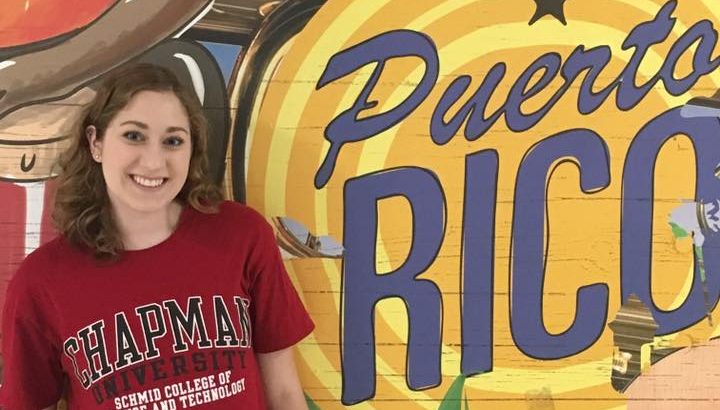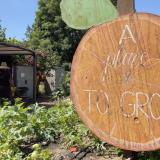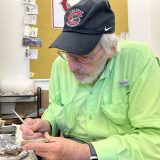
Research: Just Do It Biological sciences senior Jessica Rush’s advice after presenting her climate change research this summer in Puerto Rico
July 10, 2017
I’m a rising senior double majoring in Biological Sciences and Spanish. Most importantly, I have been a “Swamp Monster” since spring semester of my sophomore year. Being a Swamp Monster means I, along with other undergraduates, work alongside Chapman faculty Dr. Jason Keller and Dr. Cassandra Medvedeff Zalman conducting research in wetland ecology. It also means I am exposed to amazing opportunities, like being able to present my research at a major conference!
By the end of May, most Chapman students are walking balls of caffeinated stress, just trying to make it through finals to emerge from their study caves and welcome summer. This spring, I too felt the normal pressure from finals week but was more terrified of what was to come. After my last exam I would have two weeks to prepare for my invited presentation, “Effects of Temperature on Humic Substance in a Northern Minnesota Peatland”, at the Society of Wetland Scientists Annual Meeting in Puerto Rico.
My Research on Climate Change
The research I worked on in the lab last summer and for all of my junior year focused on the process of humic substance reduction in a Minnesota peatland. Peatlands are a type of wetland that play a major role in the Earth’s climate. Because they are flooded environments, the microbes that live there have to use something besides oxygen in order to breathe. Humic substance reduction is basically just that, microbes can breathe the humic substances found in the organic matter of the soil. My research focuses on how temperature affects this process to better understand the dynamics occurring between peatlands and climate change. Last summer, I had the chance to collect samples for my work from the SPRUCE project in Minnesota, and I spent the past year running samples and analyzing data.
Presenting at an International Conference in My Field: What It’s Really Like
The conference took place from June 5th to June 8th at the Puerto Rico Convention Center. We arrived June 5th to humid, 95 degree weather. The first day was a welcome mixer with the following three days filled with symposia and contributed sessions on a mix of different wetland types and topics including conservation and policy. Each day also had different events available like the student mixer, a poster session and a Women in Wetlands lunch (something cool to attend as someone involved with Chapman’s Women in Science and Technology).
I was scheduled to present the last day of the conference, in the last slot of the morning session. As if I wasn’t feeling enough pressure, I was scheduled to follow Dr. Keller’s own presentation. The great part about my slot though was that many in the room were familiar with the peatland I researched, and with one another, so it was a good community of scientists to present to.
If you ask me to recall my presentation, replay how it went, I couldn’t. From the second that timer started, counting down my fifteen minutes, my mind blacked out. But this kind of black out was more of a cruise control. I had practiced it so many times, had so many freak-outs about it that it was just time to give it my best shot. Was it the best I had ever practiced it? No. But afterwards, I got the biggest sense of relief and pride after showing people the hours I spent in the lab and the field were worth it.
Pro Tip 1: Relax and Have a Conversation
One of my biggest takeaways from this conference was to learn not to be so nervous. Of course that’s what everyone says, and I didn’t listen to them. It’s really true though. Absolutely no one is sitting in that room waiting to rip you to shreds after your presentation. Everyone is there to learn about what you know and they have no idea if you forgot to mention that one sentence about that one part in your methods. There is no penalty for putting in a quick side note or answering a question about something you forgot at the end. The conference as a whole also becomes way more enjoyable when you aren’t sitting in someone else’s talk trying to focus on a presentation when all you can think about are your own slides.
My best advice for relaxing is to be as comfortable as possible. I remember making a joke at the very beginning of my presentation and I instantly felt better. Also, presenting is about having a conversation, not just reading off your results. We watched some really engaging talks and, truthfully, some less than stellar presentations and these people are the real deal, what us undergraduates aspire to be! The ones that always pulled me in were when the presenter barely looked at their slides (which had little text and mostly pictures) and tried to pull the audience into their story. For me, one of the most interesting talks was about how the diversity of the environment affects health. The talk was not one of my favorites because of the topic, but because the speaker was so excited to share it with us.
Pro Tip 2: Network
Another great aspect of conferences was the networking. You literally have the top people in your area of research all in one room. I personally wish I hadn’t been so nervous and focused on my presentation so that I could have branched out and met more faculty. Those I did meet were so welcoming and reassuring (they also loved seeing undergraduates there who are considering going into the field).
The most refreshing part about talking to all these people was that not one of them knew this is what they were going to do. They didn’t necessarily know it during grad school either! As someone who just changed career paths and is struggling to determine what’s next after Chapman this was incredibly refreshing to hear.
Pro Tip 3: Just Do It
Attending this conference has been the most valuable experience of my undergrad. I have both Schmid College and Office of Undergraduate Research and Creative Activity (OURCA) to thank for getting the funds for me to attend it (#chapmansciences)!
Also, if you’re an undergrad and are even slightly interested in research, do it. Try it, even if it’s only a semester. It doesn’t necessarily have to be in an area you want to do the rest of your life. I wanted to be a Swamp Monster because of all the opportunities they gave to undergrads, the supportive faculty mentors and, of course, our amazing mascot and t-shirts. And now I’m considering a career in wetland biogeochemistry!
If you ever get to present your research, do it. It will make you a better researcher and student. I know it made me one and I’m excited to try some new research this summer as I’ll be participating in an environmental health research internship at UC Berkeley for two months.
Post-Script on Being a Double Major
Though this whole Puerto Rican adventure relates much more to my science side, it was also amazing to be able to go to a place where both Spanish and English are spoken. It was a really unique way to combine both of my majors, and it showed me that studying both was the right decision.
Peace, love, wetlands.

It was great to present my own research but one of my favorite parts was watching Dr. Keller and Dr. Zalman present their research.

Explaining the methods of my research midway through my presentation.

The group of wetland scientists that presented on their SPRUCE research during the conference.

Representing our lab in Puerto Rico! #swampmonsters

